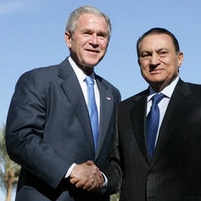Egypt Protestors Seize Torture Files…Will U.S. Cases be Revealed?
Tuesday, March 08, 2011
 George W. Bush and Hosni Mubarak (photo: White House)
George W. Bush and Hosni Mubarak (photo: White House)
Described as Egypt’s version of the French storming of the Bastille in 1789, hundreds of protestors last weekend invaded the headquarters of former President Hosni Mubarak’s intelligence force, taking with them a large volume of files that may shed light on the government’s torture program that was supported by the United States.
The Egyptian Organization for Human Rights estimates that there may have been 17,000 political prisoners during the Mubarak regime, some of whom were among the protestors who broke into the State Security offices. “Some former prisoners sobbed as they saw their old cells, recalling electric shocks and severe beatings,” reported Hannah Allam of McClatchy Newspapers.
American involvement with Egypt’s secret police began as early as 1995, and expanded during the Bush administration’s secret rendition program. During the administration of President Bill Clinton, the CIA wanted a place where it could interrogate terrorism suspects without being subject to U.S. law. Egypt was the perfect candidate because it was receiving billions of dollars a year in U.S. aid and, during the reign of dictator Hosni Mubarak, it was known to practice torture.
One of the earliest reported collaborations was in September 1995, when American agents in Croatia helped kidnap accused Egyptian terrorist Talaat Fouad Qassem, who fled the country after participating in the assassination of Egyptian president Anwar Sadat. After interrogating him aboard a ship in the Adriatic Sea, U.S. agents delivered Qassem to their Egyptian counterparts. Qassem then disappeared for good. The CIA continued to send kidnapped suspects to Egypt, where they would submit questions to be put to the suspects. The Egyptian interrogators would use their usual techniques and then return with the answers.
After the terrorist attacks of September 11, 2001, the Bush administration loosened the already limited restrictions on the rendition program. According to Jane Meyer of The New Yorker, the Egyptians once returned a suspect to the U.S. wrapped head to foot in duct tape. Another suspect, who had cooperated with the Americans, reported that in Egypt he had spent days chained to a toilet while guards urinated on him.
In at least one case, U.S. support for Egyptian torture backfired badly. Torture subjects will often say whatever they think the interrogators what to hear, just so that the torture will stop. Libyan Ibn al-Sheikh al-Libi, who had been in charge of an al-Qaeda training camp in Afghanistan, was sent to Egypt by the CIA. He got the Egyptians to stop torturing him by telling them that Saddam’s government had trained al-Qaeda terrorists in the use of chemical and biological weapons. It wasn’t true, but it was what the Americans wanted, and Colin Powell and other Bush administration figures anonymously quoted Libi to justify the U.S. invasion of Iraq in 2003.
-David Wallechinsky, Noel Brinkerhoff
Egyptian Protesters Storm State Security Headquarters in Search of Torture Files (by Hannah Allam, McClatchy Newspapers)
Egyptians Turn Anger Toward State Security Agency (by Sarah El Deeb, Associated Press)
Will Mubarak be Replaced by Egypt’s “Mr. Torture”? (by Noel Brinkerhoff, AllGov)
Mubarak…America’s Torture Partner (by Noel Brinkerhoff and David Wallechinsky, AllGov)
Source for Colin Powell’s Fake UN Claim of Iraq-al-Qaeda Connection Dies in Libyan Prison (by Noel Brinkerhoff, AllGov)
Outsourcing Torture (by Jane Mayer, New Yorker)
- Top Stories
- Unusual News
- Where is the Money Going?
- Controversies
- U.S. and the World
- Appointments and Resignations
- Latest News
- Can Biden Murder Trump and Get Away With it?
- Electoral Advice for the Democratic and Republican Parties
- U.S. Ambassador to Greece: Who is George Tsunis?
- Henry Kissinger: A Pre-Obituary
- U.S. Ambassador to Belize: Who is Michelle Kwan?






Comments